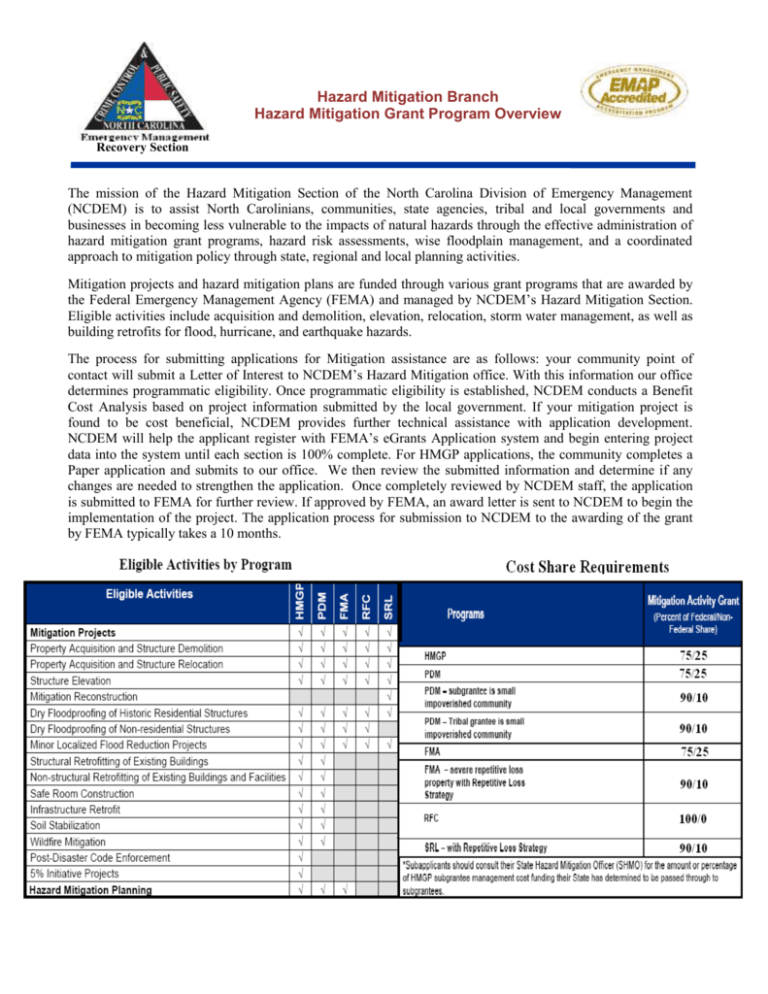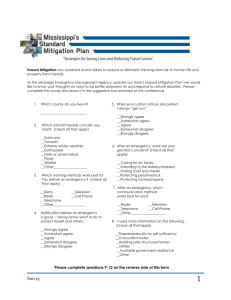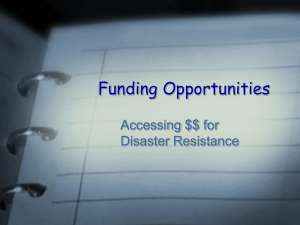The mission of the Hazard Mitigation Section of the North Carolina
advertisement

Hazard Mitigation Branch Hazard Mitigation Grant Program Overview Recovery Section The mission of the Hazard Mitigation Section of the North Carolina Division of Emergency Management (NCDEM) is to assist North Carolinians, communities, state agencies, tribal and local governments and businesses in becoming less vulnerable to the impacts of natural hazards through the effective administration of hazard mitigation grant programs, hazard risk assessments, wise floodplain management, and a coordinated approach to mitigation policy through state, regional and local planning activities. Mitigation projects and hazard mitigation plans are funded through various grant programs that are awarded by the Federal Emergency Management Agency (FEMA) and managed by NCDEM’s Hazard Mitigation Section. Eligible activities include acquisition and demolition, elevation, relocation, storm water management, as well as building retrofits for flood, hurricane, and earthquake hazards. The process for submitting applications for Mitigation assistance are as follows: your community point of contact will submit a Letter of Interest to NCDEM’s Hazard Mitigation office. With this information our office determines programmatic eligibility. Once programmatic eligibility is established, NCDEM conducts a Benefit Cost Analysis based on project information submitted by the local government. If your mitigation project is found to be cost beneficial, NCDEM provides further technical assistance with application development. NCDEM will help the applicant register with FEMA’s eGrants Application system and begin entering project data into the system until each section is 100% complete. For HMGP applications, the community completes a Paper application and submits to our office. We then review the submitted information and determine if any changes are needed to strengthen the application. Once completely reviewed by NCDEM staff, the application is submitted to FEMA for further review. If approved by FEMA, an award letter is sent to NCDEM to begin the implementation of the project. The application process for submission to NCDEM to the awarding of the grant by FEMA typically takes a 10 months. Detailed information concerning all mitigation grant programs can be found in FEMA’s Unified Hazard Mitigation Assistance (UHMA) guidance, which can be downloaded directly from FEMA’s website (www.fema.gov). This document is published on an annual basis and outlines each program, common deadlines, and eligible activities. The mitigation programs contained in the UHMA Unified Guidance include: Disaster Mitigation Grant Hazard Mitigation Grant Program (HMGP) The Hazard Mitigation Grant Program (HMGP) provides grants to states and local governments to implement long-term hazard mitigation measures after a major disaster declaration. The purpose of the HMGP is to reduce the loss of life and property due to natural disasters and to enable mitigation measures to be implemented during the immediate recovery from a disaster. The HMGP is authorized under Section 404 of the Robert T. Stafford Disaster Relief and Emergency Assistance Act. Annually Recurring Non-Disaster Grants Pre-disaster Mitigation (PDM) program The Pre-Disaster Mitigation program provides funds to states, territories, Indian tribal governments, communities, and universities for hazard mitigation planning and the implementation of mitigation projects prior to a disaster event. Funding these plans and projects reduces overall risks to the population and structures, while also reducing reliance on funding from actual disaster declarations. PDM grants are awarded on a nationally competitive basis and without reference to state allocations, quotas, or other formula-based allocation of funds. Flood Mitigation Assistance (FMA) program The FMA program is authorized by Section 1366 of the National Flood Insurance Act of 1968, as amended (NFIA), 42 U.S.C. 4104c, with the goal of reducing or eliminating claims under the National Flood Insurance Program (NFIP). FEMA provides FMA funds annually to assist states and communities in implementing measures that reduce or eliminate the long-term risk of flood damage to buildings, manufactured homes, and other structures that are insurable under the National Flood Insurance Program (NFIP). Repetitive Flood Claims (RFC) program The Repetitive Flood Claims (RFC) grant program was authorized by the Bunning-Bereuter-Blumenauer Flood Insurance Reform Act of 2004 (P.L. 108–264), which amended the National Flood Insurance Act (NFIA) of 1968 (42 U.S.C. 4001,et al). Up to $10 million is available annually for FEMA to provide RFC funds to assist States and communities reduce flood damages to insured properties that have had one or more claims under the NFIP. Severe Repetitive Loss (SRL) program The Severe Repetitive Loss grant program was authorized by the Bunning-Bereuter-Blumenauer Flood Insurance Reform Act of 2004, which amended the National Flood Insurance Act of 1968 to provide funding to reduce or eliminate the long-term risk of flood damage to severe repetitive loss (SRL) structures insured under the National Flood Insurance Program (NFIP). The SRL program seeks to mitigate residential properties that are covered under an NFIP flood insurance policy and: (a) That has at least four NFIP claim payments (including building and contents) over $5,000 each, and the cumulative amount of such claims payments exceeds $20,000; or (b) For which at least two separate claims payments (building payments only) have been made with the cumulative amount of the building portion of such claims exceeding the market value of the building. The Hazard Mitigation Section looks forward to assisting your community to participate in these programs. For more information, please contact: North Carolina Division of Emergency Management Recovery Branch -Hazard Mitigation Section 1830-B Tillery Place - Raleigh, NC 27604 - 919-715-8000 Rev. 1/19/2011





